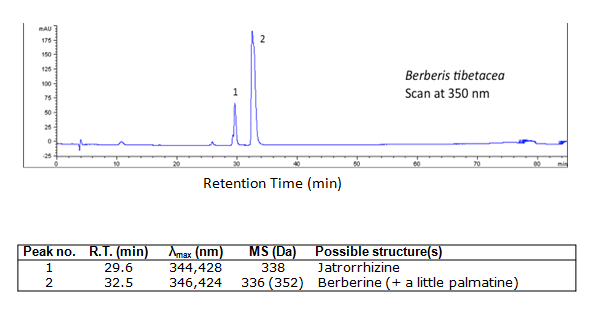Difference between revisions of "Berberis dye (berberis tibetasia) LC"
| (3 intermediate revisions by 2 users not shown) | |||
| Line 1: | Line 1: | ||
| − | [[ | + | [[Fg|thumb|''' from Denver Botanic Gardens]] |
== Description == | == Description == | ||
| Line 7: | Line 7: | ||
| − | = Summary of results = | + | == Summary of results == |
| − | = Analytical instrumentation and procedures = | + | == Analytical instrumentation and procedures == |
| + | HPLC-DAD-MS analysis was performed with an Agilent 1100 liquid chromatography system consisting of an automatic injector, a gradient pump, a HP series 1100 DAD, and an Agilent series 1100 VL on-line atmospheric pressure ionization electrospray ionization mass spectrometer. Separations were done on a Vydac 214TP52 analytical column (2.1 mm diameterX250 mm; 5-ím particle size). The column was eluted at a flow rate of 0.2 mL/min with a tertiary gradient of water (A),acetonitrile (B), and 1% (v/v) aqueous formic acid (C) with the following elution program: 0 min, 90% A, 5% B, 5% C; 0-55 min, a linear gradient to 35% A, 60% B, 5% C; 55-60 min, a linear gradient elution to 15% A, 80% B, 5% C; 60-62 min, isocratic elution at 15% A, 80% B, 5% C; 62-70 min gradient elution to 90% A, 5% B, 5% C; and reequilibration with the latter solvent for 15 min. The mass spectrometer was run both in the negative and positive ion mode. | ||
| − | = Chromatograms = | + | == Chromatograms == |
''berberis tibetasia'' dyed silk sample (direct dye without mordant) was extracted and the extract was injected in HPLC-DAD-MS for analysis. | ''berberis tibetasia'' dyed silk sample (direct dye without mordant) was extracted and the extract was injected in HPLC-DAD-MS for analysis. | ||
| − | HPLC-DAD profile and | + | HPLC-DAD profile and compounds identified |
[[File:Tibet beberry.PNG|center|frame|Absorbance at 350nm (mAU)]] | [[File:Tibet beberry.PNG|center|frame|Absorbance at 350nm (mAU)]] | ||
| − | sample information | + | == sample information == |
[[File:Tbb1.PNG|center|frame|Absorbance at 350nm (mAU)]] | [[File:Tbb1.PNG|center|frame|Absorbance at 350nm (mAU)]] | ||
| − | = Identified compounds = | + | == Identified compounds == |
| − | [[[SliderGallery rightalign| | + | [[[SliderGallery rightalign|~HPLC-DAD|RutiG~Rutin UV-Vis|ieg.jpg~Quercetin UV-Vis]]] |
{| class="wikitable" | {| class="wikitable" | ||
| Line 65: | Line 66: | ||
| − | [[Category:Analysis | + | [[Category:Dye Analysis]] |
| + | [[Category:Reference Materials]] | ||
| + | [[Category:Natural Dyes]] | ||
Latest revision as of 09:21, 29 September 2017
thumb| from Denver Botanic Gardens
Description
Historical importance
Summary of results
Analytical instrumentation and procedures
HPLC-DAD-MS analysis was performed with an Agilent 1100 liquid chromatography system consisting of an automatic injector, a gradient pump, a HP series 1100 DAD, and an Agilent series 1100 VL on-line atmospheric pressure ionization electrospray ionization mass spectrometer. Separations were done on a Vydac 214TP52 analytical column (2.1 mm diameterX250 mm; 5-ím particle size). The column was eluted at a flow rate of 0.2 mL/min with a tertiary gradient of water (A),acetonitrile (B), and 1% (v/v) aqueous formic acid (C) with the following elution program: 0 min, 90% A, 5% B, 5% C; 0-55 min, a linear gradient to 35% A, 60% B, 5% C; 55-60 min, a linear gradient elution to 15% A, 80% B, 5% C; 60-62 min, isocratic elution at 15% A, 80% B, 5% C; 62-70 min gradient elution to 90% A, 5% B, 5% C; and reequilibration with the latter solvent for 15 min. The mass spectrometer was run both in the negative and positive ion mode.
Chromatograms
berberis tibetasia dyed silk sample (direct dye without mordant) was extracted and the extract was injected in HPLC-DAD-MS for analysis.
HPLC-DAD profile and compounds identified
sample information
Identified compounds
| Compound | RT (min.) | MW | UV/vis | Other | |
|---|---|---|---|---|---|
| palmatine | 32.5 | 351 | 348,428 | minor component | |
| jatrorrhizine | 29.6 | 337 | 348,428 | ||
| berberine | 32.5 | 335 | 348,428 | major component |
References
[1] [2] [3]

